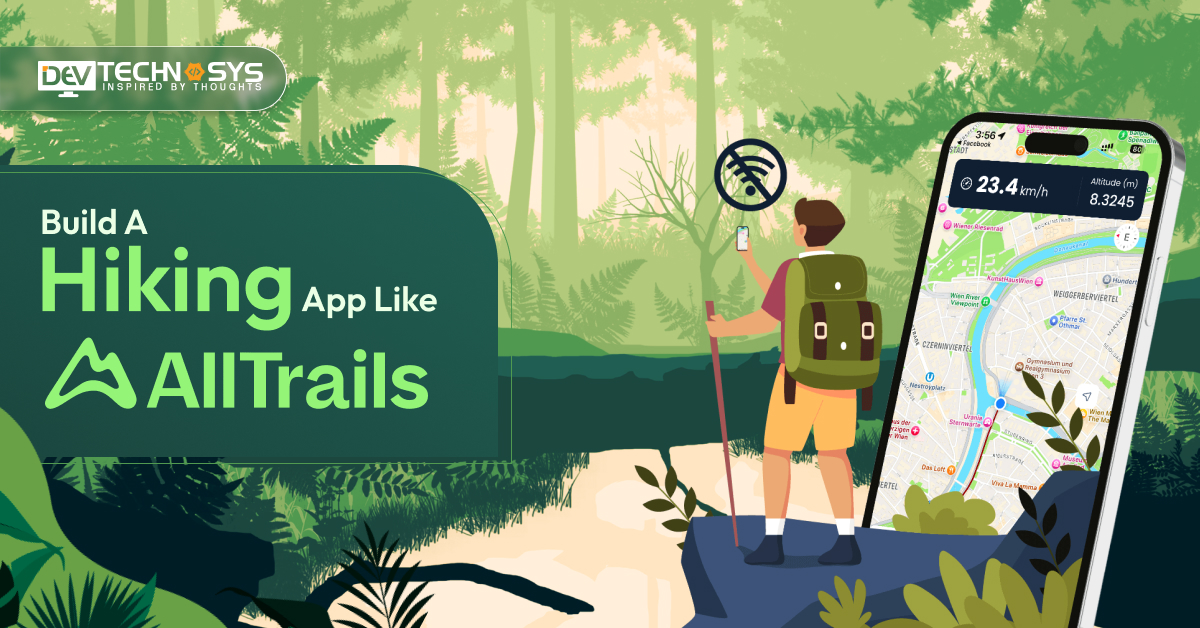“Hike, Run, Bike”
Nowadays, going to an adventure spot on a bike is a trend, and most people go to hill stations on vacation. But going in the right direction is one of the most common concerns in those locations due to their poor connectivity.
We introduce an app like AllTrails that allows users to access the map offline and easily reach their destination. It helps users guide them outdoors by offering a wide range of maps and trails.
Recently, we just scroll the web pages, guess what? We found useful information that the hiking applications market was valued at around $1,891.39 million in 2024. This is expected to increase to $2,923.52 million by the end of 2031.
By showing the above information, it is clear that investing in hiking app development is a golden opportunity for today’s entrepreneurs to expand their business globally.
In this dynamic blog, we will provide detailed information on how to build a hiking app like AllTrails, as well as other related topics.
What is AllTrails?
AllTrails is a prominent outdoor-themed smartphone app and website. It has a large database of trails for hiking, jogging, and bicycling, together with maps, user reviews, images, and difficulty ratings. If businesses create an app like AllTrails, Users may find new routes, navigate offline with a premium membership, log their actions, and share their outdoor adventures.
- Extensive Trail Database
- GPS Navigation
- Offline Maps (Premium)
- Custom Route Planning
Market Stats of Global Hiking Applications
- The market for hiking apps was estimated to be worth $1.89 billion in 2024. A rise of $2.92 million by the end of 2031 is anticipated.
- In a research, we found that the hiking mobile applications market is expected to reach a compound annual growth rate of42% from 2025 to 2031.
- The market for hiking apps worldwide has been divided into three segments: adventure tourists, professional hikers, and casual hikers. In 2025, casual hikers held the most market share, accounting for 12%.
- The market for hiking apps worldwide has been divided into three segments: web-based, iOS, and Android. In 2025, Android held the biggest market share, at 49%.
- Market growth is driven by outdoor activities, adventure tourism, health awareness, and smartphone apps, GPS, augmented reality, and real-time mapping.
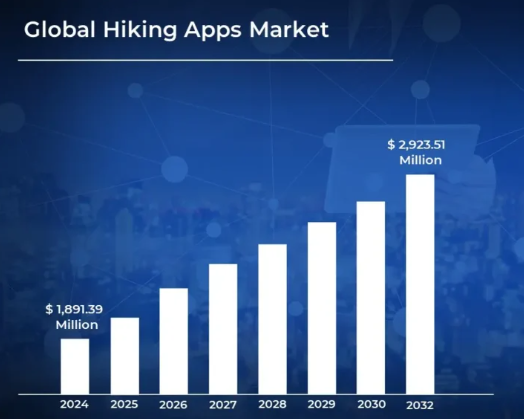
10 Ideal Hiking Apps Like AllTrails
Discover 10 best hiking trail app like AllTrails! Explore alternatives offering diverse features like advanced GPS, detailed topo maps, safety tools, and specialized trail data for your next adventure.
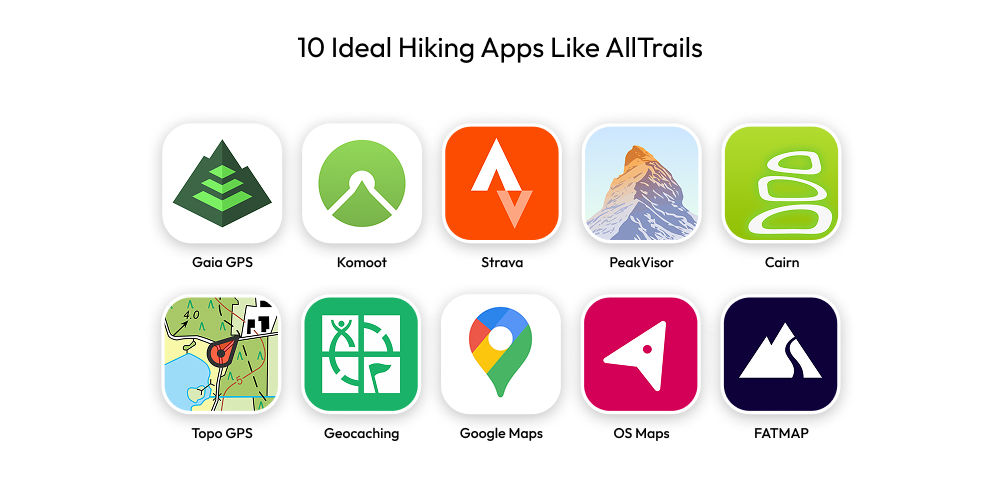
| Applications | Download Users | Stores Ratings | Apps Launched On | Platform Accessibility |
| Gaia GPS | 1M+ | 4.7 | 2009 | iOS, Android, Web |
| Komoot | 1M+ | 4.6 | 2010 | iOS, Android, Web |
| Strava | 100M+ | 4.7 | 2009 | iOS, Android, Web |
| PeakVisor | 1M+ | 4.8 | 2016 | iOS, Android |
| Cairn | 500K+ | 4.4 | 2014 | iOS, Android |
| Topo GPS | 100K+ | 4.6 | 2015 | iOS, Android |
| Geocaching | 10M+ | 4.7 | 2000 | iOS, Android |
| Google Maps | 1B+ | 4.2 | 2005 | iOS, Android, Web |
| OS Maps | 1M+ | 4.5 | 2010 | iOS, Android, Web |
| FATMAP | 100K+ | 4.3 | 2013 | iOS, Android, Web |
Why Today’s Entrepreneurs Invest in Hiking App Development?
Today’s entrepreneurs are increasingly investing in hiking on demand app development for several compelling reasons, reflecting a confluence of evolving consumer behavior, technological advancements, and burgeoning market opportunities.
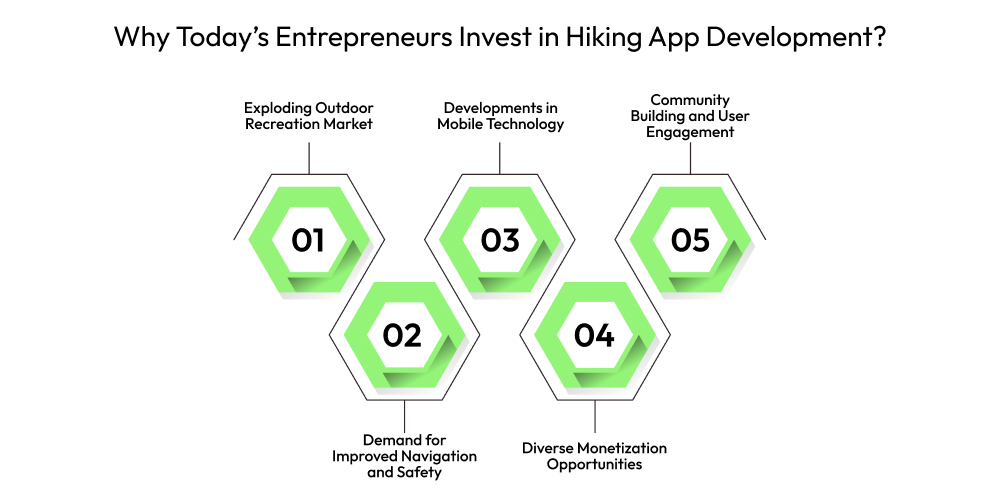
1. Exploding Outdoor Recreation Market
Outdoor activities, particularly hiking, have increased dramatically since the outbreak. Nature-based leisure is becoming increasingly popular for both physical and mental health. This increased participation translates directly into a larger, more engaged user base for hiking applications, resulting in a profitable industry. According to reports, the worldwide hiking app industry will develop rapidly in the future years.
2. Demand for Improved Navigation and Safety
Modern hikers, from simple strolls to multi-day excursions, want dependable navigation and safety gear. Hiking applications cover this need by providing accurate maps, GPS tracking, real-time location sharing (similar to “Lifeline” capabilities), and emergency warnings. Entrepreneurs see this vital need and are developing smart solutions that give peace of mind while also improving the whole outdoor experience.
3. Developments in Mobile Technology
Smartphones’ omnipresent nature, along with increased GPS capabilities, longer battery life, and fast CPUs, make them perfect platforms for complicated hiking apps. Entrepreneurs can utilize these technological advancements to develop applications that incorporate features such as augmented reality (AR) for trail visualization, AI-powered recommendations, and seamless integration with wearable devices.
4. Diverse Monetization Opportunities
Beyond basic free functionality, hiking applications provide a variety of appealing revenue options. Entrepreneurs may create freemium models that include premium subscriptions for offline maps, enhanced planning tools, and unique content. GPS tracking app development services are a financially viable enterprise thanks to their numerous income streams.
5. Community Building and User Engagement
Hiking is frequently a communal activity, and apps may help develop a strong feeling of community. Entrepreneurs are capitalizing on this by adding services for sharing trail experiences, photographs, reviews, and interacting with other hikers. This user-generated content not only adds to the app’s database, but it also increases engagement, strengthens brand loyalty, and offers vital data for continual improvement..
How Can AI Help Hiking Applications in Their Operations?
- AI analyzes user preferences, fitness levels, and past activities to suggest highly relevant trails.
- AI processes data from various sources (weather, user reports) to provide accurate, up-to-date trail status.
- AI identifies potential hazards like sudden weather changes or difficult terrain, warning users proactively.
- AI can review user-generated content (reviews, photos) for quality, relevance, and appropriateness, ensuring data integrity.
- AI-powered chatbots assist users with questions, provide instant information, and offer personalized guidance.
7 Powerful Steps to Build a Hiking App Like AllTrails
Finally, you reach the section where you can build a hiking app like AllTrails. We provide every information from market analysis to post-launch maintenance services. So, here we provide the successful hiking mobile app development process:

1. Market Research & User Needs
Let’s start to build an app like AllTrails, identify target users: hikers, adventurers, nature lovers. Analyze competitors like AllTrails. Hire dedicated developers to gather insights on desired features such as trail maps, difficulty ratings, and offline access.
Use surveys and user interviews to validate the demand and shape the app’s value proposition effectively.
| Who are our primary competitors? |
| What key trends are shaping the industry? |
| What does an ideal solution look like? |
2. Define Core Features
Include must-haves: GPS navigation, trail search, filters (difficulty, length, elevation), offline maps, user reviews, and photos. Prioritize safety features like emergency alerts and location sharing.
A clean, intuitive interface will enhance the user experience and promote regular engagement.
| What’s the most crucial mapping layer needed? |
| What real-time navigation features are essential during a hike? |
| How will offline map access be handled? |
3. Choose the Right Tech Stack
Let’s move to the third stage to create an app like AllTrails, select technologies for scalability and performance. Use React Native or Flutter for cross-platform development. Hire mobile app developers to integrate GPS, geolocation APIs, and mapping tools like Mapbox or Google Maps. The backend should support real-time data updates and store user data securely with cloud infrastructure.
| Backend language: which is best? |
| Database choice: SQL or NoSQL? |
| Mapping API: Google, Mapbox, other? |
4. Build Trail Database
Create a comprehensive trail database via public APIs, user-generated content, and partnerships with parks or hiking communities. Ensure trail details include length, difficulty, elevation, photos, and safety tips. Regular updates maintain accuracy and build trust with the user base.
| Data sources: where to find? |
| Trail attributes: what to include? |
| Data validation: ensuring accuracy? |
5. Develop & Test MVP
You need to assemble a highly skilled team from a mobile app development company to start with a Minimum Viable Product featuring essential tools like trail discovery, maps, and GPS tracking. Use agile development to build and iterate quickly. Conduct thorough testing across devices to catch bugs and refine UX based on real user feedback.
| Platform focus: iOS or Android first? |
| Performance metrics: what to track? |
| Bug reporting: clear process needed? |
6. Monetization Strategy
Entering the sixth stage to develop an app like AllTrails, choose sustainable revenue streams: freemium model, in-app purchases (e.g., offline maps), ads, or subscriptions for premium features. Ensure pricing aligns with user expectations. Offer value that justifies the cost, such as exclusive trails, downloadable content, or enhanced safety tools.
| Freemium model: what’s premium? |
| Subscription tiers: feature differences? |
| Ad integration: minimal user impact? |
7. Launch, Market & Scale
In the last stage to create a hiking app like AllTrails, hire an Android app development company to launch an app with a marketing push: social media, influencer collaborations, outdoor forums, and SEO. Gather early user feedback to optimize features. Scale by adding trails, enhancing personalization, and forming partnerships with outdoor brands or tourism boards to expand your app’s reach.
| Launch platforms: App Store, Play Store? |
| Marketing channels: best reach? |
| Customer support: user problem resolution? |
10 Features for Hiking Applications That Must Be Integrated
To be truly competitive and provide immense value, a hiking application must integrate a robust set of features. Here are 10 essential ones:
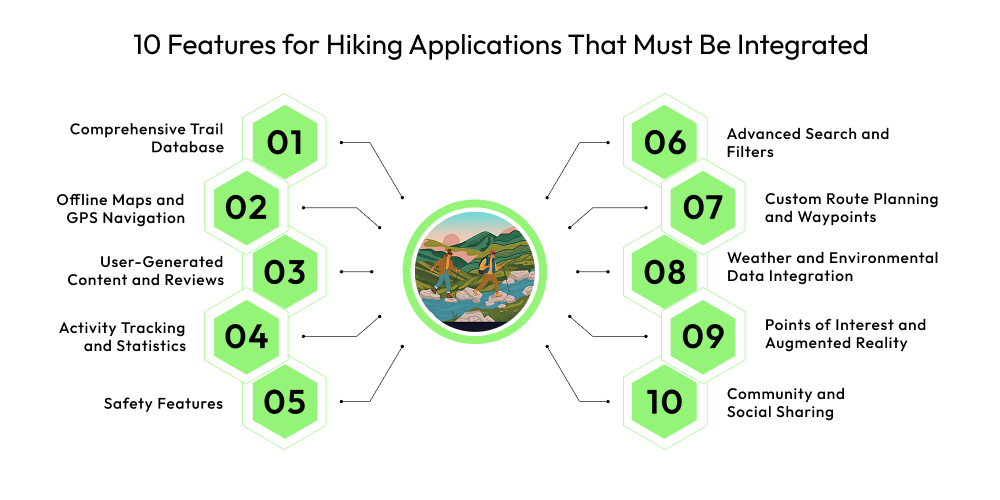
1. Comprehensive Trail Database
The AllTrails clone apps offer a large and often updated collection of trails with information such as length, elevation gain, difficulty, topography, and places of interest.
2. Offline Maps and GPS Navigation
AllTrails similar apps allow users to download precise topographic maps and rely on their device’s GPS for real-time tracking, route navigation, and position determination.
3. User-Generated Content and Reviews
Encourage people to share their experiences with images, reviews, and advice. This fosters a thriving community, delivers real insights, and keeps trail data current and relevant.
4. Activity Tracking and Statistics
AllTrails clone apps allow users to track their hikes, runs, and rides. Display vital parameters such as distance, pace, elevation changes, calories burned, and even heart rate if wearables are incorporated.
5. Safety Features
AllTrails similar apps enable users to share live location with trusted contacts, issue SOS notifications in an emergency, and even contain first-aid information.
6. Advanced Search and Filters
Users want easy ways to locate paths. Filters should include location, distance, difficulty, elevation, activity type (e.g., hiking, bicycling, trail running), dog-friendliness, child-friendliness, and other relevant factors.
7. Custom Route Planning and Waypoints
AllTrails alternatives enable users to create their own routes or modify existing ones. The option to create custom waypoints for water sources, vistas, and campsites is quite useful.
8. Weather and Environmental Data Integration
Real-time weather predictions, air quality indices, and pollen counts specific to the trail site. This enables users to prepare sufficiently and make educated judgments.
9. Points of Interest (POI) and Augmented Reality
Highlight natural sights, historical places, bathrooms, and water refill stations along the path. AR overlays can help you visually identify peaks and objects in the terrain.
10. Community and Social Sharing
AllTrails alternatives allow users to follow friends, discuss completed activities, find popular routes in their network, and connect with other outdoor lovers.
The Cost to Build a Hiking App Like AllTrails
The cost to develop a hiking app like AllTrails varies significantly based on complexity, features, and development team location. A basic MVP (Minimum Viable Product) might range from $8,000 to $15,000.
However, a feature-rich, scalable app with advanced GPS, AI integration, extensive trail data, and robust backend infrastructure, comparable to AllTrails, could easily cost $16,000 to $25,000+. Factors like UI/UX design, platform (iOS/Android), and ongoing maintenance also contribute significantly to the total investment.
| Hiking App Development | Estimated Cost | Time Frame |
| Basic App Development | $8000 – $12000 | 2 to 4 Months |
| Mid-Premium App Development | $14000 – $19000 | 5 to 8 Months |
| High-Premium App Development | $25000+ | 9+ Months |
5 Key Factors That Affect the Hiking App Development Cost
The cost of a GPS tracking app development solution depends on complexity. Key drivers include features (basic vs. advanced GPS/AI), platform choice (iOS, Android, cross-platform), UI/UX design intricacy, team location and experience, and ongoing maintenance needs.
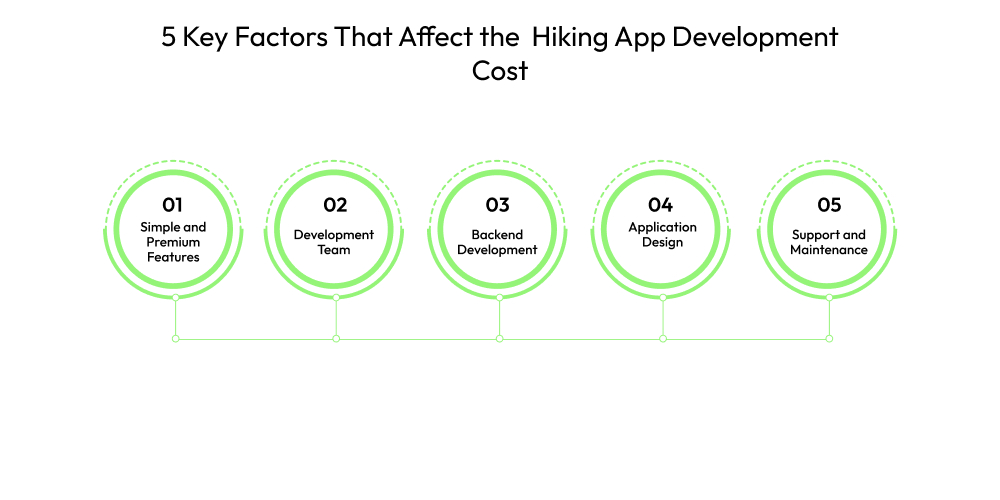
1. Simple and Premium Features
The cost rises as the sophistication and number of features increase. Basic functionality, such as trail browsing and rudimentary tracking, is inexpensive.
Premium features like as offline maps, enhanced GPS navigation, AI-powered suggestions, augmented reality, and real-time weather integration need much more development time, specialized APIs, and complicated algorithms, which raises the overall Hiking app development cost.
| Basic Features | Estimated Cost | Advanced Features | Estimated Cost |
| Trail search and Browse | $6,000 – $9,000 | Offline downloadable maps | $4,000 – $7,000 |
| Basic trail details | $4,000 – $7,000 | Turn-by-turn voice navigation | $3,000 – $5,000 |
| User reviews and ratings display | $8,000 – $12,000 | Custom route planning | $10,000 – $14,000 |
| Simple map view of trails | $7,000 – $11,000 | AI-powered personalized | $7,000 – $10,000 |
| User profile creation | $10,000 – $12,000 | Dynamic elevation profiles | $10,000 – $15,000 |
2. Development Team
Your development team’s experience, size, and geographic location all have a significant impact on AllTrails app development cost. Hiring a highly experienced team from an IT consulting company with higher hourly rates (for example, North America or Western Europe) will cost more than hiring a team from Eastern Europe or Asia.
A larger team with specialized positions (UI/UX designers, backend engineers, and QA testers) also increases the cost of mobile app development.
| Developers Experience level | United States | United Kingdom | Southeast Asia | Eastern Europe |
| Junior-level | $15 – $25 | £14 – £24 | $12 – $22 | $10 – $20 |
| Mid-level | $30 – $50 | £27 – £44 | $25 – $35 | $25 – $33 |
| Senior-level | $60 – $80 | £50 – £65 | $40 – $55 | $40 – $50 |
3. Backend Development
The backend is the app’s unseen infrastructure, which handles data, user accounts, and server-side logic. A powerful backend capable of supporting millions of users, real-time data processing, safe data storage for vast trail information, and smooth API connections (e.g., mapping services, weather APIs) are critical.
Building and maintaining this complicated server-side architecture incurs enormous AllTrails app development cost.
| Backend Complexity | Estimated Cost (USD) | Estimated Time |
| Basic Backend | $5,000 – $10,000 | 3 – 6 weeks |
| Advanced Backend | $10,000 – $18,000 | 6 – 10 weeks |
4. Application Design
A compelling and intuitive user interface (UI) and user experience (UX) are critical to app success, yet they increase mobile app development cost. Complex animations, original visuals, distinct branding components, and an extraordinarily smooth user experience need several design hours.
While a crowded or badly designed software may be less expensive at first, it frequently leads to low user retention and requires costly redesigns in the future.
| Design Quality | Cost Estimation |
| Basic Design | $8,000 – $12,000 |
| Complex Design | $15,000 – $22,000 |
5. Support and Maintenance
App development is not a one-time expenditure. Post-launch support and maintenance are critical to long-term success. This includes bug repairs, security upgrades, compatibility modifications for newer operating systems, feature additions, and server monitoring.
Neglecting maintenance can result in app instability, security flaws, and a bad user experience, costing more in lost users and reputation.
| Service Level | Description | Estimated Annual Cost (USD) | Estimated Time |
| Basic Support | Bug fixes, minor updates | $3,000 – $6,000 | Ongoing |
| Comprehensive Support | Frequent updates, performance optimization | $6,000 – $9,000 | Ongoing |
How to Make Money From Hiking Apps Like AllTrails?
Best hiking apps like AllTrails leverage several monetization strategies to generate revenue, often employing a combination of these approaches to cater to different user segments.
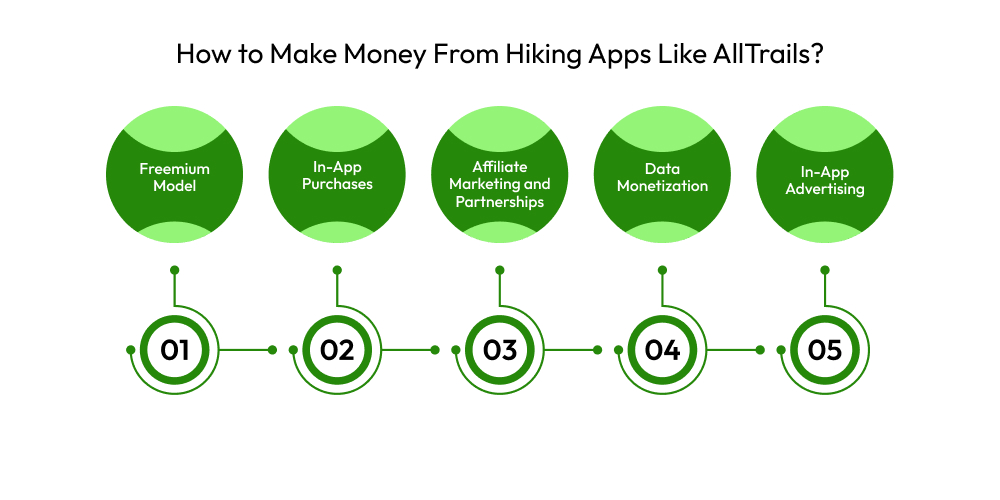
1. Freemium Model
This is the most popular and successful model. The app provides a free version with fundamental functions such as trail Browse, rudimentary maps, and user feedback. Users pay a monthly or annual membership fee to have access to enhanced features.
Premium features frequently include offline map downloads, real-time GPS navigation, bespoke route planning, safety features (such as Live Share/Lifeline). AllTrails Pro is an excellent example.
2. In-App Purchases
While IAPs are less popular for fundamental functions in hiking apps, they can nevertheless generate cash. This might involve purchasing customized digital guides for certain locations or trails, obtaining unique badges or awards, or gaining access to premium material such as extensive historical information about trail markers.
3. Affiliate Marketing and Partnerships
The apps for hiking may collaborate with outdoor gear stores, local tour operators, lodging providers, and even wellness companies. They receive a commission when users click on integrated affiliate links and make a purchase through the app.
This results in a synergistic interaction that provides value to consumers through discounts or relevant items while also earning income for the application.
4. Data Monetization
Hiking applications with a big user base collect useful information about popular trails, usage trends, and user demographics. According to the iPhone app development company, this aggregated and anonymised data may be sold to market research companies, tourism boards, and city planners.
To preserve user confidence, this must be done with complete openness and rigorous respect to privacy standards.
5. In-App Advertising
While not ideal for user experience, well-placed, non-intrusive advertisements can produce cash. Native advertisements integrate in with the app’s content (such as sponsored trail suggestions).
Rewarded video advertising might provide viewers with a tiny in-app advantage (such as brief access to a premium feature) in return for watching an advertisement. This is increasingly frequent in free-to-play apps, but it should be used wisely.
Conclusion
To develop a hiking app like AllTrails, it needs a strategic approach, blending robust GPS tracking app development company expertise with a deep understanding of user needs. Success hinges on selecting the right tech stack, meticulously crafting a comprehensive trail database, and iterating through MVP development and testing. Crucially, a well-defined monetization strategy is essential for sustainability, followed by a strong launch, marketing, and scaling plan.
Frequently Asked Questions
Q1. How Much Does it Cost to Build a Hiking App Like AllTrails?
The cost to develop a hiking app like AllTrails ranges from $10,000 for a basic MVP to over $25,000 for a full-featured, scalable application, depending on complexity, features, and development team.
Q2. How Much Time Does It Take To Create a Hiking App Like AllTrails?
The time to create a hiking app like AllTrails varies greatly. A basic MVP might take 3-6 months, while a full-featured, highly polished app with advanced functionalities and robust backend can easily take 8-12 months or even longer.
Q3. Which Technologies Are Used to Make a Hiking App Like AllTrails?
To make a hiking app like AllTrails, use Swift/Kotlin for native mobile development or React Native/Flutter for cross-platform. They integrate mapping APIs (Google Maps, Mapbox), robust backends (Node.js, Ruby on Rails with PostgreSQL/MongoDB), and scalable cloud infrastructure (AWS, Google Cloud).
Q4. What Monetization Strategies Are Most Effective for Hiking Apps?
Freemium models with premium subscriptions are most effective. Users pay for advanced features like offline maps, detailed navigation, and safety tools, ensuring recurring revenue. Affiliate marketing also generates income.
Q5. What Kind of Analytics Should Be Tracked for a Hiking App?
For a hiking app, track user engagement (DAU/MAU, session duration), feature usage, retention/churn rates, and monetization conversions. Additionally, monitor technical performance like crash rates and loading times for optimal user experience.
